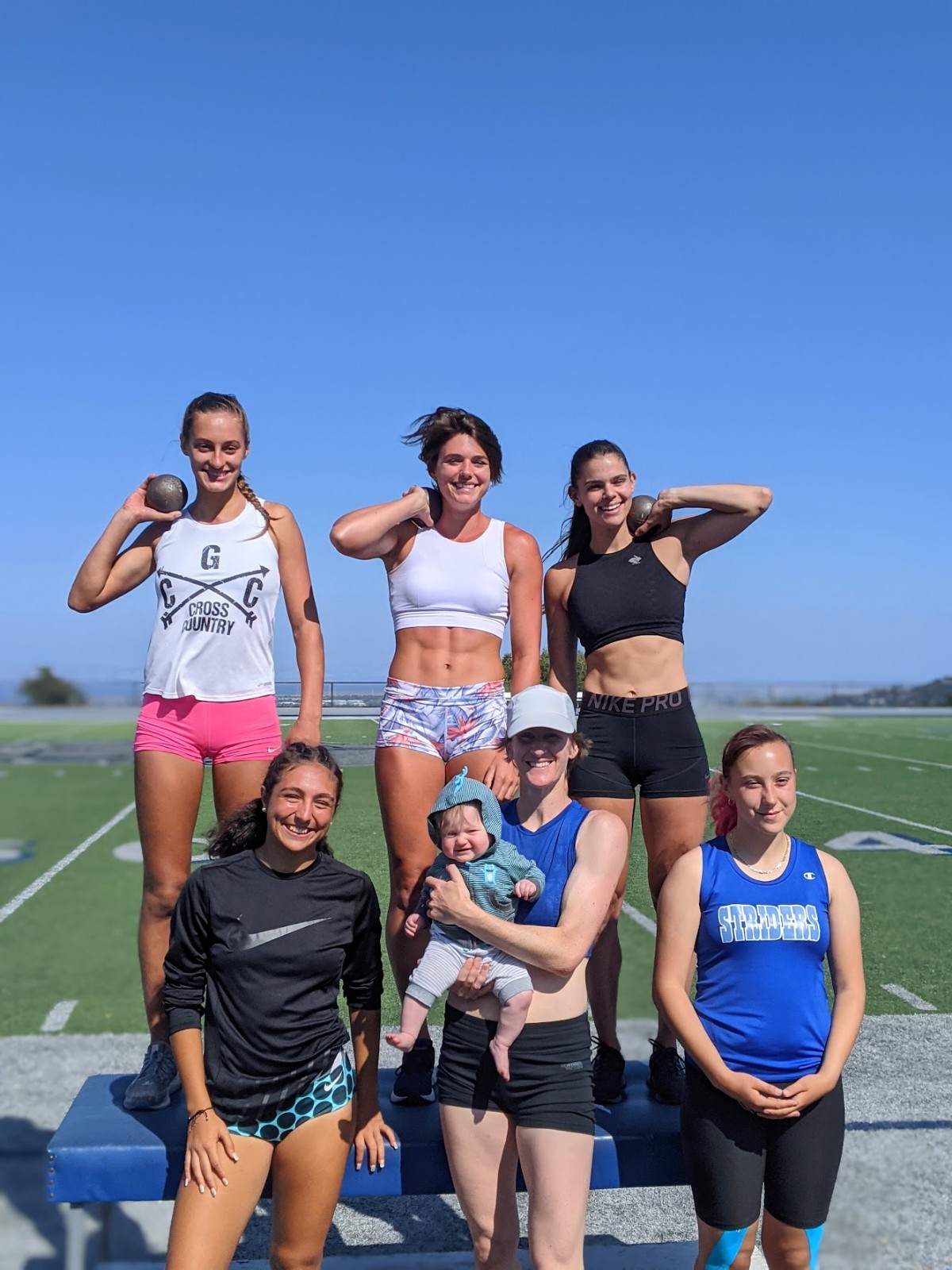“Training for the decathlon as a woman can get lonely at times,” says AnnaLee McGregor, “but the Women’s Decathlon Association Championships is such a great opportunity to compete with other female decathletes. You feel like you’re not crazy for training all year for this one chance – because there are other women doing the same thing.”
Imagine a decathlon where women are treated as the stars of the competition, rather than an inconvenience. An athlete-centred two days of ten events, with all the disciplines in the correct order. And an environment where pioneering female decathletes celebrate and honour their seven-event sisters, while having the freedom to choose ten events for themselves.
Thanks to the efforts of the Women’s Decathlon Association, the College of San Mateo meeting in California – host to the national championships – was that occasion in 2019 and again in 2021.
Three of the decathletes who have competed in the meet – US decathlon record-holder Jordan Gray, former 400m-runner AnnaLee McGregor, and former pole-vaulter Hanna McPhee – reflect on their love of decathlon and the joy of experiencing a competition built around female decathletes.
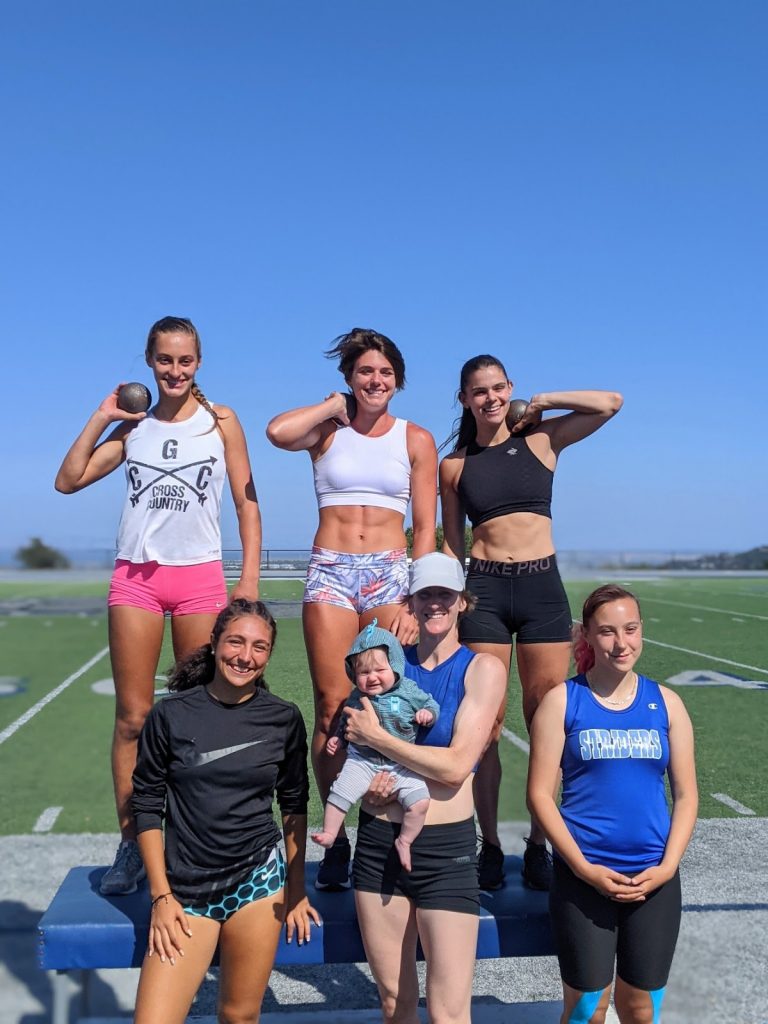
JORDAN’S EXPERIENCE
If world record-holder Austra Skujytė is the greatest female decathlete of all time, then Jordan Gray is the face of the movement to give more girls and women the opportunity to pursue the title of “the world’s greatest athlete.”
After scoring an American record of 7921 at the June 2019 iteration of the San Mateo decathlon, exceeding the 19-year-old mark of 7577 by Tiffany Lott-Hogan,
Jordan has been a tour de force in promoting women’s right to compete in decathlon.
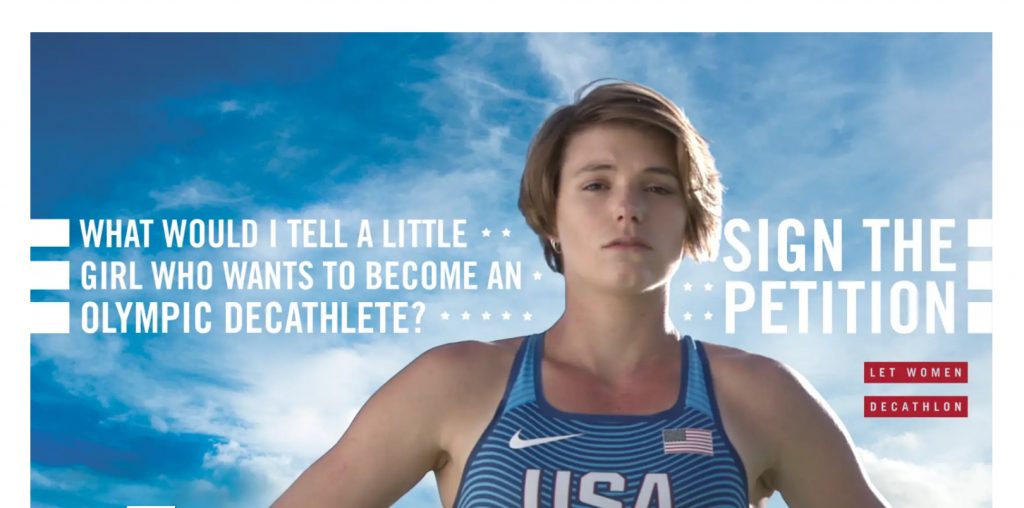
Her “Let Women Decathlon” petition was launched in February 2021 and now has almost thirty thousand signatures. Organisations who can’t quite believe that women in 2022 are still not given the opportunity to compete in an event that has been on the Olympic schedule for over a century for men have started to add their weight to the cause.
The campaign has been covered by the New York Times and NBC, among others, and earlier this year Jordan added “Ted Talk” to her resume.
Gray has also set up a Facebook group for female decathletes, and those who support them, to share details of competitions and provide mutual support.
But the time and effort on campaigning has not distracted Gray from her first love, training for and competing in decathlon. In August 2021, she returned to San Mateo to add 325 points to her American record, scoring 8246 and moving past Marie Collonvillé of France (8150) into the all-time number two position behind Skujytė’s mark of 8358.
In 2019, Gray’s US record of 7921 consisted of the following marks:
12.16m (+0.5) 100m, 6.18m (-0.4) long jump, 12.86m shot, 1.65m high jump, 57.41s 400m; 14.10s (+1.1) 100mh, 39.09m discus, 3.71m pole vault, 39.83m javelin, 5:26.14s 1500m.
The wind had not done much to aid Jordan in 2019, but in 2021 the gusts were ferocious. The organisers were keen to get the right balance between providing the athletes with the opportunity to take advantage of the favourable conditions, while ensuring that any mark Gray scored was valid for record purposes.
In combined events, there are three events for which marks are accompanied by a wind reading: the 100m, the long jump and the hurdles. While in individual events the maximum legal wind reading is +2m per second, in combined events it is the average wind over those three events which counts. For a score to be valid, the average of the three scores must be no more than +2m per second.
“We had a very windy 100m and a very windy long jump,” Jordan recalls, “so we needed a headwind of at least 0.6 metres per second in the hurdles, and we got 2.5. So that hurt trying to run into a wind that strong!”

Gray’s first day included an 11.86s 100m, 6.12m long jump, 14.25m shot, 1.71m high jump and 57.27s 400m.
“In the 400m, my goodness we all got out so fast. We came through 200 almost as fast as we would come through our regular 200 – and then you just took the curve and the wind tried to knock you back on your foot…”
Her second day marks were 14.43s hurdles, 39.84m discus, a huge pole vault PB of 3.91m and a 41.14m javelin.
“Right at the end, my coach came up to me and he said, ‘If you run 5:23.5 or faster, you will beat Solomon’s (Simmons, her long-time training partner) PR and officially have a bigger decathlon score’. I ran the first 400m way too fast, but I was like I’m going to PR, or I’m going to die. There is no in-between. And so, I ended up running 5:20 and I got it done. And the first thing I said after the 1500m – this is still better than the 800m!”
“Going into the decathlon, my goal was to break 8000 points – if I break 8000, I break the American record again. And I got really close to the world record, and a few people asked me if was going for it. But no – I just beat my goal by 246 points, so that was super exciting.”
While the scoring tables are different for men and women, fans of combined events know that 8000 points is the gateway to world class in the decathlon, and the world record holder Austra Skujytė is keen to see others attack her mark. “I want girls to beat my record,” the Lithuanian told Decathletes of Europe in an interview recently.
Jordan has not had the opportunity to attempt the world record since her performance in 2021, having undergone surgery for a recurring shoulder problem.
She has also relocated from the balmy environs of Georgia to the more robust climate of Wisconsin, following her long-time coach Andy Eggerth to his new position as Head Track and Field coach at the University of Wisconsin River Falls.
The role of a supportive coach such as Eggerth, and the likes of Vincent Delcros (coach to Belgian decathlon record holder Cassandre Evans) can’t be overstated in decathlon. Their role goes well beyond training to acting as important allies in seeking out competitive opportunities, correcting lazy misconceptions, and defending female decathletes’ right to, well, exist.
“I get so many messages from girls saying, ‘I do the heptathlon and I want to learn pole vault but my coach won’t let me,’” says Jordan. “I had a coach send me a message once, saying that coaches already spend so much of their lives on the track, and if you make girls do decathlon, they’re going to have to spend more hours out there. And I was like ‘yes, now you will have to give your girls the same amount of attention you give your boys!”
“When you have a good coach that’s really willing to let you do it – like Cassandre – that’s so important. There are girls out there who really want to learn decathlon, and no-one to coach them.”
“In San Mateo, there are always such supportive women there, and it’s more like everyone is just cheering everybody else on, you’re not really competing against each other. And while it’s normally like that in the combined events, it’s even more so with the women’s decathlon – just because it’s such a “pioneer” kind of era, and so everybody wants everyone to PR.”
ANNALEE’S EXPERIENCE
AnnaLee McGregor has done more decathlons than any woman in history.
She has pursued every option to compete at ten events – joining men’s competitions, tagging onto masters’ meetings and finally had the opportunity to be part of the line-up at the US Women’s Decathlon Championships in San Mateo in both 2019 and 2021
Originally a 400m runner, she completed her seventh decathlon in August 2021 just seventh months after giving birth to her daughter in January.
“It’s just so pleasant!” AnnaLee says of the novelty of a decathlon organised solely for women. “You get your hurdles set up. Everything starts on time. I’m sure collegiate and professional male athletes get that all the time. But for us, it’s such a treat.”
For most female athletes returning after pregnancy and childbirth, there are a set of challenges on the route back to competition. For female decathletes, there’s an additional hurdle.
“I was worried I wasn’t going to do well enough,” says AnnaLee. “I thought, if I hurt myself, you’re going to look bad for women’s decathlon. But I really wanted to do it.”
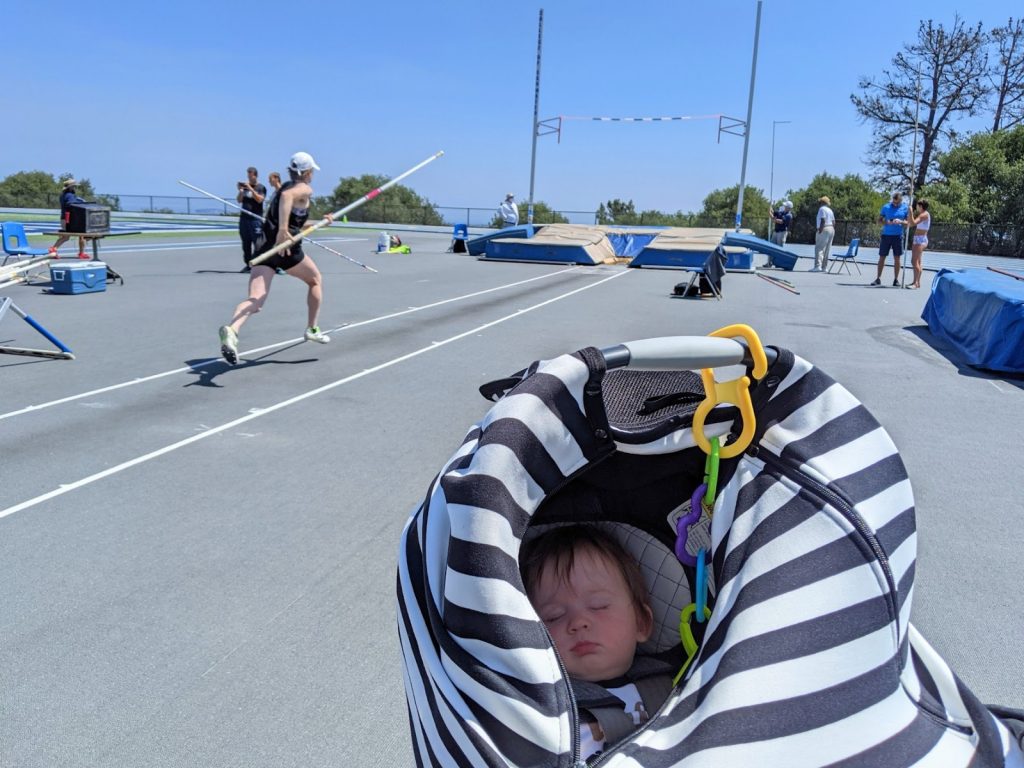
“When I started doing decathlon, there weren’t many other women. So, I figured it would make a world of difference to have another competitor there, whether I did well or not. I would support them either way – and if I’m there, I know I’m going to want to be competing!”
McGregor’s PR is 6330 from 2019, and she made her way to that score from a college career in the 400m.
“I’ve loved racing ever since I was able to walk, and I looked forward to high school because I could finally do track.”
“The first time my coach put me in the 400m, I just hid. But then I grew to love it. I was just in love with the 400m and 4x400m. I always wanted to try other events, but in college unless you’re recruited for the multis, you can’t switch into it. I didn’t have too many successful marks in the field events in high school. I would try high jump, but I usually had to leave early to run the 400m, or I’d be throwing up after the 400m!”
“I did four years at UC San Diego and I held the 400m record for a short period of time. After college I thought I was done with track and field and I was kind of depressed about it. But then I got to do a season of indoor track at San Francisco State where I was doing my masters. That’s where I started practising other events. And one day, Dimitry Yakoushkin (the co-founder of the Women’s Decathlon Association) came up to me and asked, ‘Have you ever thought about doing the multis?'”
“They entered me into a pentathlon. But I didn’t know how to hurdle. I ended up chickening out and running the 400m and 200m instead.”
“So, the very first multi I did was in 2014, and it was a decathlon. I didn’t even know it was an option for women until Dimitry told me. I thought – oh that has a 400m in it. I’ll do great at that! And I fell in love with decathlon.”
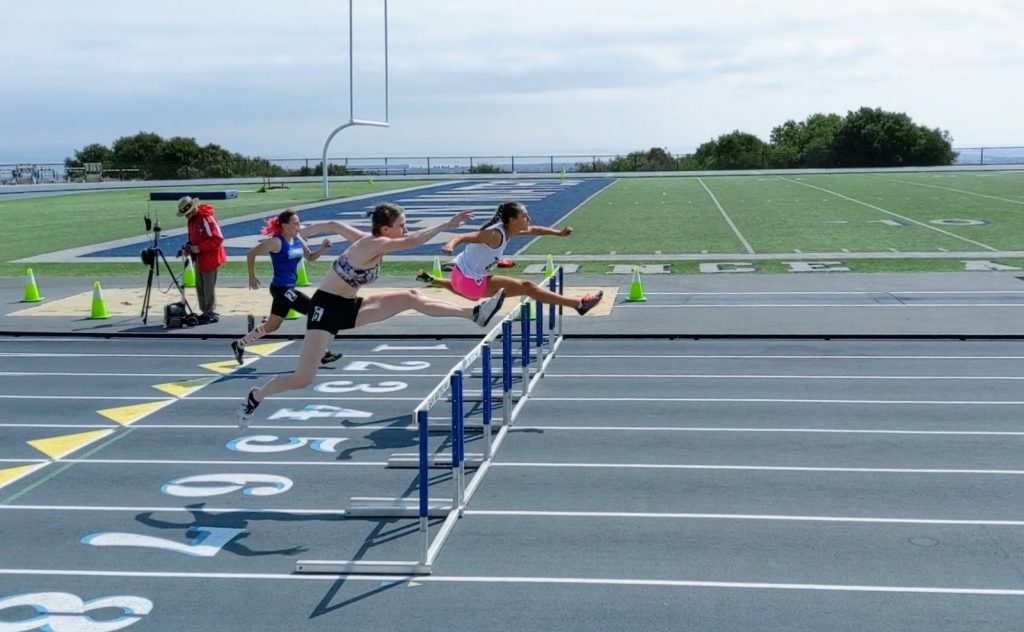
McGregor’s score in her very first decathlon was 6110. She improved on that in 2019, where she finished second to Gray with her current PB of 6330.
“A huge part of attracting women is the records list” she says, referring to the information compiled by the Women’s Decathlon Association.
“Young girls are looking at that and thinking – I can beat that. I can be on that list. That’s what got me interested in really pushing myself. In some events I thought – ok these marks are good, but I can get that many points.“
“You will likely only have one competition per year, and it’s unlikely that all ten events will go well at every meet. Jordan and Corinn (Brewer, who surpassed the US high school record when finishing second) broke records – just imagine how good the records would be if women had more meets and competitors available to them.”
“It’s another reason I just want to be out there. I don’t feel I need to be the best athlete out there to inspire young athletes. They just need another person out there.”
With strong sprints in her repertoire, and her aversion to the hurdles tackled, the next challenge for AnnaLee was the pole vault.
“I was like, sure I’ll do nine out of ten, but the pole vault was the one thing I didn’t have any interest in, because I just thought it was dangerous. We started practising and I got over the fear I would just slide down the pole as soon as it lifted me off the ground. I fell in love with that too, but I’m still kind of afraid of it. Somehow, I got myself over eight foot eight (2.64m) with the tiniest pole ever!”
AnnaLee started hunting down opportunities to pursue her new-found passion. “I’ve said that I was lucky in finding so many decathlons to compete in, but really luck had nothing to do with it. Dimitry sought out opportunities for female decathletes, and still does.”
“Masters meets are usually welcoming to everybody. There weren’t other women back then, but I was happy to go with the men because they just pushed me harder.”
While male decathletes and female heptathletes can plan their season with a reasonable amount of confidence, for female decathletes there is much more at stake.
“Every time there’s an opportunity to do a decathlon, I’ll do it. Because you never know if you’re going to get that opportunity again,” AnnaLee points out.
“If someone is willing to host you during a decathlon, especially if I’m the only woman competing, I just feel so grateful to be there. But you don’t get that answer very often.”
“One time, we were trying to get officials to straighten out the high jump bar, because one side was at least six inches higher than the other. We finally gave up because we don’t want to be annoying.”
It’s a fine balance that every woman will recognise throughout her life. Speak up for yourself and risk being labelled ‘difficult.’ Challenge poor treatment and risk being excluded altogether. But none of that has discouraged AnnaLee, and she is optimistic about the future.
“I look forward to the day that women can enter a decathlon just as easy as men. They can train and compete for it as collegiate athletes, and maybe even have female training partners!”
“Training for the decathlon as a woman can get lonely at times but the Women’s Decathlon Association Championships is such a great opportunity to compete with other female decathletes. You feel like you’re not crazy for training all year for this one chance – because there are other women doing the same thing.”
“Decathlon is so addictive. It’s so hard to have every event go well, so I keep going back to it and thinking next time these events will be better. When I hit 35, I’ll be in a different age bracket with new records for motivation.”
“I was there competing (in San Mateo) because I enjoy it, no matter what condition my body is in. If people like myself who love the decathlon are too afraid to do it, then nothing is going to change. If women didn’t push for it, we wouldn’t even have the heptathlon.”
HANNA’S EXPERIENCE
While AnnaLee had discovered her passion for decathlon at home in California, Hanna McPhee’s journey towards ten events started three thousand miles across the country at Brown University in Rhode Island.
Hanna was a pole vaulter in college, but she had a front row seat into the world of decathlon.
“I knew the decathlon well, because at the time I was dating a decathlete from Brown who went onto compete for Team USA. The closeness and camaraderie I saw in decathlon always interested me,” she recalls.
“Coming out of college, I wanted to keep doing track to stay in shape. I knew I didn’t want to do just pole vault; in part I knew I wouldn’t have the facilities for it, but doing the event you’ve done for ten years out of college is maddening – do I want to nit-pick for another decade on it?”
Hanna moved to California, where her Brown track and field sweatshirt caught the eye of Yakoushkin. “He approached me on the track one day and asked if I would be interested in doing the multis. And I said yes.”
“I was never a technical pole vaulter. I was a brute vaulter – really strong and a ton of grit. And it turns out that makes me a great decathlon pole vaulter, if not a great individual pole vaulter. I love that when I’m tired, when it’s windy, I can hit a PR.”
“I’m a Steady Eddie. I knew from being good at training really hard and having a lot of grit that multis might be fun. AnnaLee was training with Dimitry, and I saw her at her peak competing, and she had just run an insanely fast, sub five 1500. I thought it was so exciting, and it was so cool to see her train. I just wanted to be involved.”
“It took me two tries to finish my first decathlon. My first one was in Texas, and I only got through day one, due to a family emergency. The first one I finished was in Grass Valley, with Masters. It was brutally hot, and the pool was huge because we were on the same timetable as the Masters men, with a huge age range and huge capabilities range.”
“All of the things that could have gone wrong went wrong – it was the hottest, record-breaking day of the summer, and the mat fell apart in the second pole vault pit so we had to all use the same one.”
“It ended up being two 12-hour days. I think the gun went off at 1030 at night, getting really close to the edge of the two days.”
“I turned to Dimitry and said I don’t know if I can do this. And he said – no, this is the hardest decathlon you will ever do in your life and I promise, it only gets better from here! And he was totally right.”
“The last decathlon I did (before the 2021 San Mateo) was the one where Jordan broke her first record. It was her first time finishing a 1500m. I knew the time she needed and so I paced her through it. Until the last 200m I was yelling at her – come on, come on!”
“It’s the camaraderie that comes in the 1500m. You’re not necessarily trying to win the race; maybe you’re trying to help someone else, or maybe you’re trying to have someone else help you. It’s just this long gruelling battle together.”
“Like all decathlons, there was a real mixture of highlights and lowlights. I do this completely for fun – I have a very full-time job and I’m starting my own business. But I felt a ton of pressure going into it, because you’ve been training for two years, so you’d better make it worth it! I’m not an elite athlete or have access to most of the facilities, so I think I practiced high jump four times this year.”
“With Covid, the past year has been a total circus trying to train for decathlon. But it was a guiding light through a pretty dark time for me personally. It gave me something to train for, something to hope for.”
“I was really excited with my 12:31s in the 100m – I’m turning 30 and in track and field there are people like Shelly-Ann Fraser-Pryce, Allyson Felix and Damian Warner proving that you can continue to get faster in your 30s. In the States, we’re taught that we are kind of washed up after your early 20s, after you do college. So, I was really excited about a huge PR in the 100m.”
“Long jump didn’t go how I wanted it to, but I had a PR in shot. I get really nervous doing throws, I think because I don’t compete in them that often. High jump was pretty rough, I just didn’t have the experience this year.”
“And then the 400…man, the wind! The wind that helped us in the 100m really hurt us. I knew Jordan was trying to get a 57. We were joking about getting out hard in the first half because we knew as soon as we were at 150m, we’re going to get a blast of wind. Jordan is stronger than me and she was able to push through it, but man, when I hit that curve I just got smacked in the face!”
“On Day 1, I was tracking for what I wanted, over 6000 points. I woke up on Day 2 worried about my hamstring, but hurdles went great. We had a headwind – which we needed in order to make sure we secured Jordan’s record. I was happy with my time, and I thought if I get through hurdles, I’m not going to pop my hamstring.”
“Discus was the event I was most worried about. I have a really hard time with the transition from hurdles to discus because I’m so hyped for the hurdles. But I didn’t foul any of the throws, so I was super proud of that.”
“But the pole vault was the heart breaker for me.”
“When I was warming up, I thought – this does not feel good. I think it was on take-off at 3.31m that I felt the burning sensation in the back of my leg. But as a seasoned pole vaulter” – Hanna’s PB is 3.51m – “I struggled over the height. I skipped the next height to try and recover, but I couldn’t make it down the runway. I thought my decathlon was over, and I told all my friends to go home”
“I did a standing, two step javelin. And then I tried warming up for the 1500m. My target this year was 5:15 but I was peg-legging and wobbling through the warm-up and crying on the backstretch. Dimitry pulled me aside and said – you’re sitting in second place. If you can stay close to the other competitors you might be able to place. But only if you think you can do it.”
“That really helped me get the heart to do it. So, I rolled it out, and got to the start line.”
“I did the first lap with a lot of pain, 120m behind who I needed to be behind in order to place. At three laps I kicked and closed the gap to 50m. And then all I needed was a hundred and I just gutted it out.”
Hanna ended up finishing in third place with a PR of 5613, adding 100 points to her previous mark from 2019.

“That was one of the proudest moments for me in track and field. It wasn’t the decathlon score I wanted by a long shot. It wasn’t very glorious. But the point of the decathlon is how far can you push yourself. How much heart do you have by the tenth event? How much do you love this sport?”
“The more finishes we have, the more decathlon scores we have on the stats table. And the more progress we’re making. That’s a huge motivator for me – so I kept pushing – for the sport.”
Hanna draws some clear parallels about her growth and confidence as a decathlete, and her growth and confidence as an entrepreneur.
She was the first employee of a start-up which made coffee and tea equipment for the home. “I watched the company grow from me and the founder to 80 plus people. It was a really exciting journey and it made me want to start my own “baby”.”
“When I first started, I never thought I would have the confidence to start my own company (Nanuelectrics). But I saw a lot of male entrepreneurs with a lot less experience than me starting their own companies and I was like – wait a second, I can do this.”
“It’s very similar – challenging my own confidence and assumptions about what women can do.”
“AnnaLee is amazing, doing a decathlon seven months after giving birth. And Jordan is just such a force of nature.”
Like AnnaLee, Hanna also credits the masters track and field community for their welcoming approach to women who want to compete in decathlon. But like both AnnaLee and Jordan, Hanna also continues to encounter barriers.
“At some meets, there’s just an attitude. You tell people you’re a decathlete, and not a heptathlete, and you get raised eyebrows. A lot of people assume you’re anti-heptathlon, and it’s just so not the case at all. It’s really frustrating. I just try and use every opportunity to showcase how much I respect and love heptathletes.”
“If you’re asking a meet director to squeeze you in with the men, it usually feels like it’s a favour. And you don’t want to ask for things like, do they have extra poles (when you’re travelling), or asking for time for a couple more warm up throws.”
“There was one situation where I was doing an indoor heptathlon, instead of the pentathlon, as a warm-up for a decathlon. And we were trying to debate whether we should run an 800m or a 1000m at the end of the heptathlon. It’s supposed to be a 1000m but there’s no points table!”
“There’s also a reason the decathlon is the way it is. The implements go from heavy to light. You have an assisted jump on day 2, when you’re more tired. But for women, “we’ll just switch it to avoid the inconvenience.” It’s such a frustrating issue, and it’s not what’s best for the athletes. Talk about putting people at risk – high jumping on day 2 is murder on your heels and ankles.”
“So, there are definitely a couple instances where you’re tiptoeing around, trying to make sure that you get invited back. Especially as someone who doesn’t score super high, you’re not coming in with the big points, and bringing a crowd.”
“But with age I’ve gotten better at asking. Because you just start to care less. For younger women for whom it’s maybe their first decathlon, and they are getting rushed and don’t want to ask for more time. I’m like “No, no – we still have time!” “
“Becca (Peters) and Dimitry go out of their way to optimise this for us, which is very rare for a women’s decathlon. They have put so much work into this, and so much heart,” Hanna concludes.

And so, thanks to the efforts of Becca Peters and Dimitry Yakoushkin of the Women’s Decathlon Association, and Fred Baer at the College of San Mateo, young female decathletes have an opportunity to compete, grow and aim for the pioneering marks laid down by Skujyté, Gray, Collonvillé, McGregor, McPhee and many more.


